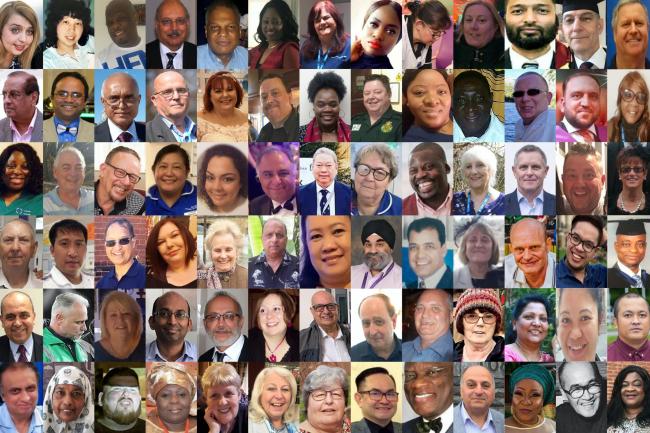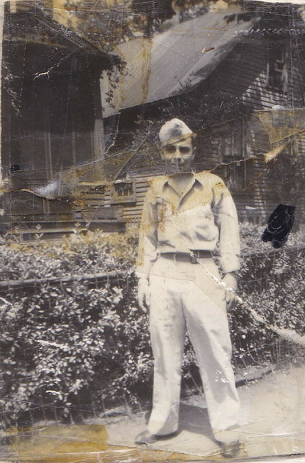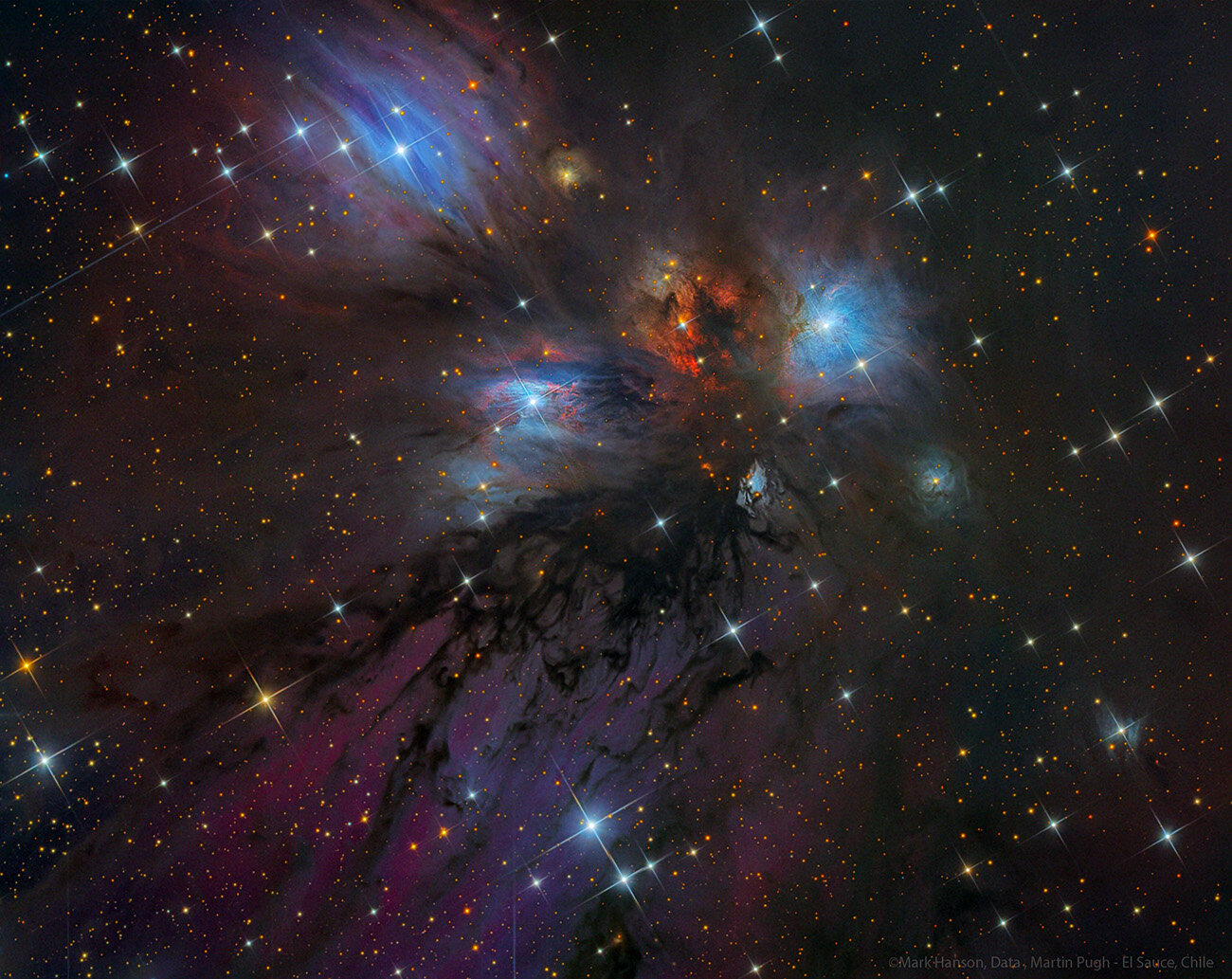Blog
To date over 345,000 people have perished from COVID-19. Let us honor all of the victims and fight to survive in our Universal Struggle.

Honoring my dad Mike Labriola who served in the US Army during WWII and suffered greatly as he served in Italy his birthplace.

Mystic Mountain is a photograph and a term for a region in the Carina Nebula imaged by the Hubble Space Telescope. The view was captured by the then-new Wide Field Camera 3, though the region was also viewed by the previous generation instrument. The new view celebrated the telescope’s 20th anniversary of being in space in 2010. Mystic Mountain contains multiple Herbig-Haro objects where nascent stars are firing off jets of gas which interact with surrounding clouds of gas and dust.
This region is about 7,500 light-years (2,300 pc) away from Earth. The pillar measures around three light-years in height (190,000 astronomical units).

Wallace Roney (May 25, 1960 – March 31, 2020) was an American jazz (hard bop and post-bop) trumpeter.
Roney took lessons from Clark Terry and Dizzy Gillespie and studied with Miles Davis from 1985 until the latter’s death in 1991. Wallace credited Davis as having helped to challenge and shape his creative approach to life as well as being his music instructor, mentor, and friend; he was the only trumpet player Davis personally mentored.
Roney was born in Philadelphia. He attended Howard University and Berklee College of Music in Boston, Massachusetts, after graduating from the Duke Ellington School of the Arts of the D. C. Public Schools, where he studied trumpet with Langston Fitzgerald of the Baltimore Symphony Orchestra. Found to have perfect pitch at the age of four, Wallace began his musical and trumpet studies at Philadelphia’s Settlement School of Music.
He studied with trumpeter Sigmund Hering of the Philadelphia Orchestra for three years. Hering regularly presented Wallace at recitals at the Settlement School, and with the Philadelphia Brass Ensemble, during his studies in Philadelphia.
more...Norman Gary Foster (born May 25, 1936) is an American musician who plays saxophone, clarinet, and flute. He is considered a crossover artist, performing jazz, pop, and classical music. He has been prominent in the film, television, and music industries for five decades, having performed on over 500 movie scores and with over 200 orchestras.
He has recorded on numerous Grammy, Academy Award, Emmy, and Golden Globe winning media and soundtracks for artists and composers such as Carol Burnett, Bob Dylan, Barbra Streisand, Mel Torme, Toshiko Akiyoshi, Frank Sinatra, Pat Williams, John Williams, Natalie Cole, Jerry Fielding, Cal Tjader, Marty Paich, and Michael Bublé.
Foster received the Most Valuable Player Award for woodwind doubling from The Recording Academy.
Gary Foster was born in Leavenworth, Kansas, in 1936. He started on the clarinet at age thirteen. His first musical inspiration was Olin Parker, a school music director and teacher who introduced him to the music of Count Basie, Woody Herman, and many other types of music. He listened closely to the Woody Herman Orchestra’s recording of “Four Brothers”, which featured saxophonists Stan Getz, Zoot Sims, and Serge Chaloff. For Foster, Getz stood out on the tenor saxophone because of his tone. Foster also acknowledged the influence of Lester Young and Charlie Parker.
Jazz critic Zan Stewart compared Foster’s style to that of Lee Konitz, Paul Desmond, and Art Pepper (West Coast Jazz style). The music of Lennie Tristano and the concepts taught to him by Warne Marsh have been of great inspiration and influence over the years.
more...Marshall Belford Allen (born May 25, 1924) is an American free jazz and avant-garde jazz alto saxophone player. He also performs on flute, oboe, piccolo, and EVI (an electronic valve instrument made by Steiner, Crumar company).
Allen is best known for his work with Sun Ra, having recorded and performed mostly in this context since the late 1950s, and having led Sun Ra’s Arkestra since 1993. Critic Jason Ankeny describes Marshall as “one of the most distinctive and original saxophonists of the postwar era.” Marshall Allen was born in Louisville, Kentucky.
During the Second World War he enlisted in the 92nd Infantry Division and was stationed in France.[3] Allen studied alto saxophone in Paris and played in Europe with Art Simmons and James Moody.
He is best known for his mastery of pyrotechnic effects on the alto – he has said that he “wanted to play on a broader sound basis rather than on chords” (1971 interview with Tam Fiofori)). The opportunity came through his long association with Sun Ra, with whom he performed almost exclusively from 1958 to Ra’s death in 1993, although he did record outside the Arkestra, with Paul Bley‘s group in 1964 and Olatunji‘s group during the mid-1960s. Critic Scott Yanow has described Allen’s playing as “Johnny Hodges from another dimension”.
more...Jimmy Hamilton (May 25, 1917 – September 20, 1994) was an American jazz clarinetist, tenor saxophonist, arranger, composer, and music educator, best known for his twenty-five years with Duke Ellington.
Hamilton was born in Dillon, South Carolina, and grew up in Philadelphia. Having originally learned to play piano and brass instruments, in the 1930s he started playing the latter in local bands, before switching to clarinet and saxophone. During this time he studied with renowned clarinet teacher Leon Russianoff. In 1939 he played with Lucky Millinder, Jimmy Mundy, and Bill Doggett, going on to join the Teddy Wilson sextet in 1940. After two years with Wilson, he played with Eddie Heywood and Yank Porter.
In 1943, he replaced Barney Bigard in the Duke Ellington orchestra, and stayed with Ellington until 1968. His style was very different on his two instruments: on tenor saxophone he had an R&B sound, while on clarinet he was much more precise and technical. He wrote some of his own material in his time with Ellington.
more...Bill “Bojangles” Robinson (May 25, 1878 – November 25, 1949) was an American tap dancer, actor, and singer, the best known and the most highly paid black American entertainer in America during the first half of the twentieth century. His long career mirrored changes in American entertainment tastes and technology. His began in the age of minstrel shows and moved to vaudeville, Broadway theatre, the recording industry, Hollywood films, radio and television. According to dance critic Marshall Stearns, “Robinson’s contribution to tap dance is exact and specific. He brought it up on its toes, dancing upright and swinging”, giving tap dancing a “hitherto-unknown lightness and presence. His signature routine was the Stair Dance, in which he would tap up and down a set of stairs in a rhythmically complex sequence of steps, a routine that he unsuccessfully attempted to patent. He is also credited with having coined the word copacetic in popular culture via his repeated use of it in vaudeville and radio appearances.
Robinson was a popular figure in both the black and white entertainment worlds of his era. He is best known today for his dancing with Shirley Templein a series of films during the 1930s, and for starring in the musical Stormy Weather (1943), loosely based on his own life and selected for preservation in the National Film Registry. He used his popularity to challenge and overcome numerous racial barriers, including becoming:
- one of the first minstrel and vaudeville performers to appear without the use of blackface makeup
- one of the earliest black performers to go solo, overcoming vaudeville’s two-colored rule[4]
- a headliner in Broadway shows
- the first black performer to appear in a Hollywood film in an interracial dance team (with Shirley Temple in The Little Colonel, 1935)
- the first black performer to headline a mixed-race Broadway production
Robinson came under heavy criticism for his tacit acceptance of racial stereotypes of the era, with critics calling him an Uncle Tom. He resented such criticism, and his biographers suggested that critics were at best incomplete in making such a characterization, especially given his efforts to overcome racial prejudice. In his public life, Robinson led efforts to:
- persuade the Dallas Police Department to hire its first black policeman
- lobby President Franklin Delano Roosevelt during World War II for more equitable treatment of black soldiers
- stage the first integrated public event in Miami, a fundraiser which was attended by both black and white city residents
In this classic celestial still life composed with a cosmic brush, dusty nebula NGC 2170, also known as the Angel Nebula, shines near the image center. Reflecting the light of nearby hot stars, NGC 2170 is joined by other bluish reflection nebulae, a red emission region, many dark absorption nebulae, and a backdrop of colorful stars. Like the common household items that still life painters often choose for their subjects, the clouds of gas, dust, and hot stars featured here are also commonly found in this setting — a massive, star-forming molecular cloud in the constellation of the Unicorn (Monoceros). The giant molecular cloud, Mon R2, is impressively close, estimated to be only 2,400 light-years or so away. At that distance, this canvas would be over 60 light-years across.

Rosanne Cash (born May 24, 1955) is an American singer-songwriter and author. She is the eldest daughter of country musician Johnny Cash and Vivian Liberto Cash Distin, Johnny Cash’s first wife.
Although Cash is often classified as a country artist, her music draws on many genres, including folk, pop, rock, blues, and most notably Americana. In the 1980s, she had a string of chart-topping singles, which crossed musical genres and landed on both the country and pop charts, the most commercially successful being her 1981 breakthrough hit “Seven Year Ache“, which topped the U.S. country singles charts and reached the Top 30 on the U.S. pop singles charts.
In 1990, Cash released Interiors, a spare, introspective album which signaled a break from her pop country past.
The following year, in 1991, Cash ended her marriage and moved from Nashville to New York City, where she has continued to write, record, and perform. Since 1991 she has released six albums, written three books, and edited a collection of short stories. Her fiction and essays have been published in The New York Times, Rolling Stone, The Oxford American, New York Magazine, and other periodicals and collections.
Cash won a Grammy Award in 1985 for “I Don’t Know Why You Don’t Want Me” and has received 12 other Grammy nominations. She has had 11 No. 1 country hit singles, 21 Top 40 country singles, and two gold records. Cash was the 2014 recipient of Smithsonian magazine’s American Ingenuity Award in the Performing Arts category.
On February 8, 2015, Cash won three Grammy awards for Best Americana Album for The River & the Thread, Best American Roots Song with John Leventhal and Best American Roots Performance for A Feather’s Not A Bird.
Cash was honored further on October 11, 2015, when she was inducted into the Nashville Songwriters Hall of Fame.
more...Patti LaBelle (born Patricia Louise Holte; May 24, 1944 Philadelphia, PA) is an American singer, songwriter, actress, and businesswoman. LaBelle began her career in the early 1960s as lead singer and front woman of the vocal group, Patti LaBelle and the Bluebelles. Following the group’s name change to Labelle in the early 1970s, they released the iconic disco song “Lady Marmalade” and the group later became the first African-American vocal group to land the cover of Rolling Stone magazine. LaBelle is commonly identified as the “Godmother of Soul”.
After the group split in 1976, LaBelle began a successful solo career, starting with her critically acclaimed debut album, which included the career-defining song, “You Are My Friend“. LaBelle became a mainstream solo star in 1984 following the success of the singles, “If Only You Knew“, “New Attitude” and “Stir It Up“, with the latter two crossing over to pop audiences and becoming radio staples.
Less than two years later, in 1986, LaBelle scored with the number-one album, Winner in You and the number-one duet single, “On My Own“, with Michael McDonald. LaBelle eventually won a 1992 Grammy for Best Female R&B Vocal Performance for her 1991 album, Burnin’, followed by a second Grammy win for the live album, Live! One Night Only. Her 1990s albums, Burnin’, Gems (1994) and Flame (1997), continued her popularity with young R&B audiences throughout the decade. Following the release of two mildly receptive solo albums in the early new millennium, she reunited with her Labelle bandmates for the album, Back to Now, followed by a briefly well received promotional tour. LaBelle’s success has extended as an actress with a notable role in the film, A Soldier’s Story, and in TV shows such as A Different World and American Horror Story: Freak Show. In 1992, LaBelle starred in her own TV sitcom, Out All Night. A decade later, LaBelle hosted her own lifestyle TV show, Living It Up with Patti LaBelle on TV One. In 2015, LaBelle took part in the dance competition, Dancing with the Stars.
In a career that has spanned fifty years, she has sold more than 50 million records worldwide. LaBelle has been inducted into the Grammy Hall of Fame, the Hollywood Walk of Fame, and the Apollo Theater Hall of Fame. LaBelle was included in Rolling Stone on their list of 100 Greatest Singers. LaBelle is a dramatic soprano and is noted for her vocal power, range and emotive delivery.
more...Bob Dylan (born Robert Allen Zimmerman; May 24, 1941 Duluth, MN) is an American singer-songwriter, author, and visual artist who has been a major figure in popular culture for more than 50 years. Much of his most celebrated work dates from the 1960s, when songs such as “Blowin’ in the Wind” (1963) and “The Times They Are a-Changin’” (1964) became anthems for the civil rights and anti-war movements. His lyrics during this period incorporated a range of political, social, philosophical, and literary influences, defied pop music conventions and appealed to the burgeoning counterculture.
Following his self-titled debut album in 1962, which mainly comprised traditional folk songs, Dylan made his breakthrough as a songwriter with the release of The Freewheelin’ Bob Dylan the following year. The album featured “Blowin’ in the Wind” and the thematically complex “A Hard Rain’s a-Gonna Fall“. For many of these songs, he adapted the tunes and phraseology of older folk songs. He went on to release the politically charged The Times They Are a-Changin’ and the more lyrically abstract and introspective Another Side of Bob Dylan in 1964. In 1965 and 1966, Dylan drew controversy when he adopted electrically amplified rock instrumentation, and in the space of 15 months recorded three of the most important and influential rock albums of the 1960s: Bringing It All Back Home (1965), Highway 61 Revisited (1965) and Blonde on Blonde (1966). Commenting on the six-minute single “Like a Rolling Stone” (1965), Rolling Stone wrote: “No other pop song has so thoroughly challenged and transformed the commercial laws and artistic conventions of its time, for all time.”
In July 1966, Dylan withdrew from touring after a motorcycle accident. During this period, he recorded a large body of songs with members of the Band, who had previously backed him on tour. These recordings were released as the collaborative album The Basement Tapes in 1975. In the late 1960s and early 1970s, Dylan explored country music and rural themes in John Wesley Harding (1967), Nashville Skyline (1969), and New Morning(1970). In 1975, he released Blood on the Tracks, which many saw as a return to form. In the late 1970s, he became a born-again Christian and released a series of albums of contemporary gospel music before returning to his more familiar rock-based idiom in the early 1980s. The major works of his later career include Time Out of Mind (1997), Love and Theft (2001), Modern Times (2006) and Tempest (2012). In the 2010s, he recorded a series of three albums comprising versions of traditional American standards, especially songs recorded by Frank Sinatra. Dylan has announced the release of a double album in June 2020, Rough and Rowdy Ways, his first album of new material in eight years. Backed by a changing lineup of musicians, he has toured steadily since the late 1980s on what has been dubbed the Never Ending Tour.
Since 1994, Dylan has published eight books of drawings and paintings, and his work has been exhibited in major art galleries. He has sold more than 100 million records, making him one of the best-selling music artists of all time. He has received numerous awards, including the Presidential Medal of Freedom, ten Grammy Awards, a Golden Globe Award and an Academy Award. Dylan has been inducted into the Rock and Roll Hall of Fame, Nashville Songwriters Hall of Fame and the Songwriters Hall of Fame. The Pulitzer Prize Board in 2008 awarded him a special citation for “his profound impact on popular music and American culture, marked by lyrical compositions of extraordinary poetic power”. In 2016, Dylan was awarded the Nobel Prize in Literature “for having created new poetic expressions within the great American song tradition”.
more...Archie Vernon Shepp (born May 24, 1937) is an American jazz saxophonist, educator and playwright who since the 1960s has played a central part in the development of avant-garde jazz.
Shepp was born in Fort Lauderdale, Florida, but raised in Philadelphia, Pennsylvania. He studied piano, clarinet, and alto saxophone before focusing on tenor saxophone. He occasionally plays soprano saxophone and piano. He studied drama at Goddard College from 1955 to 1959.
He played in a Latin jazz band for a short time before joining the band of avant-garde pianist Cecil Taylor. Shepp’s first recording under his own name, Archie Shepp – Bill Dixon Quartet, was released on Savoy Records in 1962 and featured a composition by Ornette Coleman. Along with John Tchicaiand Don Cherry, he was a member of the New York Contemporary Five. John Coltrane‘s admiration led to recordings for Impulse! Records, the first of which was Four for Trane in 1964, an album of mainly Coltrane compositions on which he was joined by trombonist Roswell Rudd, bassist Reggie Workman and alto player John Tchicai.
more...More Posts
- The Cosmos with GAL-CLUS-022058s
- Joe Pass
- Melba Liston
- Danny Barker
- World Fusion with Labess
- Daily Roots with the Skulls
- Surviving the Pandemic and Realizing Racial Justice
- The Cosmos with NGC 1097
- George Duke
- Long John Baldry
- Ronald Shannon Jackson
- Jay McShann
- José Limón
- Mississippi Fred McDowell
- World Music with Aditya Prakash
- Daily Roots with the Nyabinghi Celebration
- Surviving the Pandemic and Realizing Racial Justice
- The Cosmos with NGC 613
- Lee Ritenour
- Cal Massey